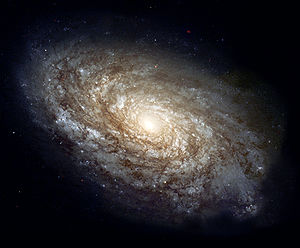
Like the order behavior shown in the image, is it due to the universality of some fundamental mathematic theory? Is there some general physics explanation for it?
- edit: This question comes after I read Terence Tao's talk on universality (pdf).

Like the order behavior shown in the image, is it due to the universality of some fundamental mathematic theory? Is there some general physics explanation for it?
- edit: This question comes after I read Terence Tao's talk on universality (pdf).
I don't see much order on this particular chaotic picture.
What I see is some localized mass. The mass is localized because of the attractive force of gravity. Also, what we could see if you included an animation is that the galaxy is spinning. That's also why the shape resembles a disk. This increase of the spinning after the gravitational collapse - or clumping - is due to the conservation of the angular momentum, see
More generally, one could ask why many systems in Nature that contain many degrees of freedom often look simpler - for example why diamond looks so nice and clear even though it's a complicated bound state of many carbon atoms. There's simply not choice because there must always exist an expansion of the behavior of a system around an infinite number of building blocks. The number of mathematically possible, qualitatively different behaviors is limited, so Nature has to recycle them.
Systems containing more than 2 bodies have been proved to be chaotic (Poincarè solved an approach to this problem with perturbation theory, when the king of Sweden proposed a problem: Solve the Solar System movement). Surely, it's been proved that one cannot express the solution of the motion of even a 3-body system in terms of algebraic formulas and integrals.
According to classical mechanics, if you know a certain state of the given system, you'll know all the evolution of the system with time, forward and backward. But the problem is that the set of equations one must solve to determine the functions ruling the movement of all the system particles is chaotic. It means that, given an initial state, you CAN predict all the system trajectory, but the system is very sensible to a slight change on the initial state. This is called deterministic chaos.
If you want to threat the phase space of a system composed with many particles like a Lioville fluid, you'll get the Boltzmann Transport equation. Which also describes the behavior of a distribution of particles. But to derive Boltzmann equation in order to describe the system behavior, one needs to make an assumption about the collisions on the system, where you lose information from one collision to another (it's been a problem for a long time, now...). It results on random chaos.
The apparent order on the system comes from a dynamical competition between the forces acting among the system's components. You can call it "interaction". A common characteristic of chaotic systems is the competing of two forces. For example, take the Earth-Sun-Moon system. Acting on each body, you have 2 forces. The order which will arise from the system depends on the tune you make for the forces' intensities and directions. And you should take care with this tune, because the behavior resulting from it may be very different from what you expect, since the system is chaotic. In order to study this kind of problem, one may call upon a lot of recent tools developed since Poincarè approach to it, in the early XX century.
Sorry for my bad english!
Best regards!